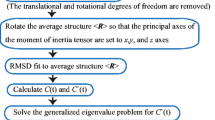Abstract
The results of NMR studies using several nuclei indicate that proteins have considerable internal mobility. The most obvious is the mobility of side-chains. This mobility is general on the exterior surfaces but extends internally in a differential way. The functional value of surface mobility concerns both on and off rates of ligand binding (e.g. metal ions and parts of substrates) and protein/protein interactions. The mobility, which indicates that recognition is more in the hand-in-glove class than in the lock-in-key class, makes for a modified view of the specificity of protein interactions. Thus, fast on/off systems cannot be as selective as slower systems. Segmental mobility of proteins is considered in the context of protein secondary structure. The least mobile segments are the β-sheet and the tight β-turn. Mobility is always possible for, but not within, rod-like helices and in loose turns. Many examples are given and the importance of mobility in molecular machines is described. Finally, examples are given of virtually random-coil proteins, segments, and linker regions between domains and the functional value of such extremely dynamic regions of proteins is discussed.
Similar content being viewed by others
References
Aguiar A, de Haas GH, Jansen EHJM, Slotboom AH, Williams RJP (1979) NMR studies of phospholipase A2. Eur J Biochem 100: 511–518
Akke M, Forsén S, Chazin WJ (1991) Structure and properties of calbindin. J Mol Biol 220: 173–189
Alsaadi BM, Rossotti FJC, Williams RJP (1980) Studies of lanthanide (II) dipicolinate complexes in aqueous solution. J Chem Soc Dalton Trans 813–822
Atkinson A (1990) The conformation of kringles and osteocalcin, D. Phil. thesis (Oxford)
Cassels R, Dobson CM, Poulsen FM, Williams RJP (1978) Study of the tryptophan residues of lysozyme using NMR. Eur J Biochem 92: 81–97
Cheetham JC, Raleigh DP, Griest RE, Redfield C, Dobson CM, Rees AR (1991) Antigen mobility in the combining site of an antibody. Proc Natl Acad Sci 88: 7968–7972
Daniels AJ, Williams RJP, Wright PE (1978) The character of stored molecules in chromaffin granules. Neuroscience 3: 573–585
Derewenda U, Derewenda Z, Dodson EJ, Bing X, Markussen J (1991) X-ray analysis of the single chain B29-A1 peptide-linked insulin molecule. A completely inactive analogue. J Mol Biol 220: 425–433
Eigen M (1960) Water exchange around cations. Z Electrochem 64: 115–130
Esnouf P, Lawrence MP, Mabbutt BC, Patthy L, Pluck N, Williams RJP (1985) The structure of kringles in prothrombin. Bull Soc Chim Belg 94: 883–896
Frausto da Silva JRR, Williams RJP (1991) The Biological Chemistry of the Elements, Oxford University Press, Oxford
Gao Y, Boyd J, Pielak GJ, Williams RJP (1991) The analysis of the NMR paramagnetic shift spectra of cytochrome c. Biochemistry 30: 7033–7040
Gao Y, McClendon G, Pielak GJ, Williams RJP (1992) Electronproton coupling in cytochrome c studied using mutants. Eur J Biochem 204: 337–352
Garrett TPJ, Saper MA, Samraoai B, Bjorkman PJ, Wiley DC (1989) Structural studies of major histocompatibility antigens. Transplantant Proc 21: 588–590
Handford PA, Mayhew M, Baron M, Winship PR, Campbell ID, Brownlee GG (1991) Key residues involved in calcium-binding motifs in EGF-like domains. Nature 351: 164–167
Harlos K, Vas M, Blake CCF (1992) The structure of phosphoglycerate kinase with substrate. Proteins 12: 133–144
Ikura M, Clore GM, Gronebaum AM, Zhu G, Klee CB, Bax A (1992) The solution structure of calmodulin. Science 256: 632–637
João HC, Taddei N, Williams RJP (1992) Investigating interdomain region mutants of phosphoglycerate kinase. Eur J Biochim 205: 93–104
Madden DR, Gorga JC, Strominger JL, Wiley DC (1992) The threedimensional structure of HLA-B27 Cell 70: 1035–1048
Mayhew M, Handford P, Baron M, Tse AGD, Campbell ID, Brownlee GG (1992) Calcium binding to EGF-like domains. Protein Engineering 5: 489–494
Neya S, Funasaki N, Nakamurâ M (1992) Dynamic analysis of heme rotation in myoglobin. Biochim Biophys Acta 1117: 243–250
Norwood TJ, Crawford DA, Steventon ME, Driscoll PC, Campbell ID (1992) NMR studies of the c-subunit of F1F0 ATP synthase. Biochemistry 31: 6285–6290
Orekhov VY, Abdulaeva GV, Musina LY, Arseniev AS (1992) NMR studies of bacteriorhodopsin. Eur J Biochem 210: 223–229
Pâstore A, Saudek V, Ramponi G, Williams RJP (1992) Three-dimensional structure of acylphosphatase. J Mol Biol 224: 427–440
Rini JM, Schulze-Gamen U, Wilson IA (1992) Flexibility of antibody loops. Science 255: 959–965
Smith LJ, Redfield C, Boyd J, Lawrence GMP, Edwards RG, Smith RAG, Dobson CM (1992) Human interleukin 4: the solution of a four-felix bundle protein. J Mol Biol 224: 899–904
Soriano-Garcia M, Padmanabhan K, Tulinsky A (1992) The structure of brothrombin. Biochemistry 31: 2554–2566
Tanswell P, Westhead EW, Williams RJP (1976) NMR studies of the active site structure of yeast phosphoglycerate kinase. Eur J Biochem 63: 249–260
Timkovich R, Walker LA, Cai M (1992) Hydrogen exchange in cytochrome c-551. Biochim Biophys Acta 1121: 8–15
Turner D, Williams RJP (1992) The 13C and 1H NMR spectra of cytochrome c. Submitted to Eur J Biochem
Vallee BL, Williams RJP (1968) Metalloenzymes: the entatic nature of their active sites. Proc Natl Acad Sci USA 59: 498–505
Wand AJ, Roder H, Englander SW (1986) Hydrogen exchange in cytochrome c. Biochemistry 25: 1107–1114
Weiss MA, Wellenberger T, Wobbe CR, Lee JP, Harrison SC, Struhl K (1990) The folding of the DNA-binding protein domain GCN4. Nature 347: 575–578
Williams RJP (1953) Metal ions in biological systems. Biological Reviews 28: 381–412
Williams RJP (1953) The function of structure and dynamics in proteins, peptides and metal ion complexes. Carlsberg Res Commun 52: 1–30
Williams RJP (1989) NMR studies of mobility within protein structure. Europ J Biochem 183: 479–497
Wittekind M, Rajagopal P, Branchini BR, Reizer J, Saier MH, Klevit RE (1992) Solution structure of phosphocarrier protein HPr. Protein Science (in press)
Wüthrich K (1986) NMR of proteins and nucleic acids. Wiley & Sons, New York
Author information
Authors and Affiliations
Additional information
This work is based on a lecture at the EBSA Symposium, organised by the Italian Biophysical Society (S.I.B.P.A.), Tabiano Terme, September 1992
Rights and permissions
About this article
Cite this article
Williams, R.J.P. Protein dynamics studied by NMR. Eur Biophys J 21, 393–401 (1993). https://doi.org/10.1007/BF00185866
Received:
Accepted:
Issue Date:
DOI: https://doi.org/10.1007/BF00185866




